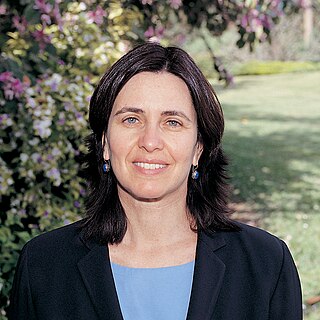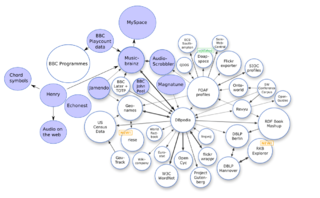Related Research Articles
Elliptic-curve cryptography (ECC) is an approach to public-key cryptography based on the algebraic structure of elliptic curves over finite fields. ECC allows smaller keys compared to non-EC cryptography to provide equivalent security.
The National Institute of Standards and Technology (NIST) is an agency of the United States Department of Commerce whose mission is to promote American innovation and industrial competitiveness. NIST's activities are organized into physical science laboratory programs that include nanoscale science and technology, engineering, information technology, neutron research, material measurement, and physical measurement. From 1901 to 1988, the agency was named the National Bureau of Standards.

David Lee Chaum is an American computer scientist, cryptographer, and inventor. He is known as a pioneer in cryptography and privacy-preserving technologies, and widely recognized as the inventor of digital cash. His 1982 dissertation "Computer Systems Established, Maintained, and Trusted by Mutually Suspicious Groups" is the first known proposal for a blockchain protocol. Complete with the code to implement the protocol, Chaum's dissertation proposed all but one element of the blockchain later detailed in the Bitcoin whitepaper. He has been referred to as "the father of online anonymity", and "the godfather of cryptocurrency".
Digital physics is a speculative idea that the universe can be conceived of as a vast, digital computation device, or as the output of a deterministic or probabilistic computer program. The hypothesis that the universe is a digital computer was proposed by Konrad Zuse in his 1969 book Rechnender Raum. The term digital physics was coined by Edward Fredkin in 1978, who later came to prefer the term digital philosophy. Fredkin encouraged the creation of a digital physics group at what was then MIT's Laboratory for Computer Science, with Tommaso Toffoli and Norman Margolus as primary figures.

Shafrira Goldwasser is an Israeli-American computer scientist and winner of the Turing Award in 2012. She is the RSA Professor of Electrical Engineering and Computer Science at MIT, a professor of mathematical sciences at the Weizmann Institute of Science, Israel, co-founder and chief scientist of Duality Technologies and the director of the Simons Institute for the Theory of Computing at the University of California, Berkeley.

Abramowitz and Stegun (AS) is the informal name of a 1964 mathematical reference work edited by Milton Abramowitz and Irene Stegun of the United States National Bureau of Standards (NBS), now the National Institute of Standards and Technology (NIST). Its full title is Handbook of Mathematical Functions with Formulas, Graphs, and Mathematical Tables. A digital successor to the Handbook was released as the "Digital Library of Mathematical Functions" (DLMF) on 11 May 2010, along with a printed version, the NIST Handbook of Mathematical Functions, published by Cambridge University Press.
Neuroinformatics is the field that combines informatics and neuroscience. Neuroinformatics is related with neuroscience data and information processing by artificial neural networks. There are three main directions where neuroinformatics has to be applied:

Open data is data that is openly accessible, exploitable, editable and shared by anyone for any purpose. Open data is licensed under an open license.

Web science is an emerging interdisciplinary field concerned with the study of large-scale socio-technical systems, particularly the World Wide Web. It considers the relationship between people and technology, the ways that society and technology co-constitute one another and the impact of this co-constitution on broader society. Web Science combines research from disciplines as diverse as sociology, computer science, economics, and mathematics.
The Digital Library of Mathematical Functions (DLMF) is an online project at the National Institute of Standards and Technology (NIST) to develop a database of mathematical reference data for special functions and their applications. It is intended as an update of Abramowitz's and Stegun's Handbook of Mathematical Functions (A&S). It was published online on 7 May 2010, though some chapters appeared earlier. In the same year it appeared at Cambridge University Press under the title NIST Handbook of Mathematical Functions.
Digital curation is the selection, preservation, maintenance, collection and archiving of digital assets. Digital curation establishes, maintains and adds value to repositories of digital data for present and future use. This is often accomplished by archivists, librarians, scientists, historians, and scholars. Enterprises are starting to use digital curation to improve the quality of information and data within their operational and strategic processes. Successful digital curation will mitigate digital obsolescence, keeping the information accessible to users indefinitely. Digital curation includes digital asset management, data curation, digital preservation, and electronic records management.

Sir Nigel Richard Shadbolt is Principal of Jesus College, Oxford, and Professorial Research Fellow in the Department of Computer Science, University of Oxford. He is Chairman of the Open Data Institute which he co-founded with Tim Berners-Lee. He is also a Visiting Professor in the School of Electronics and Computer Science at the University of Southampton. Shadbolt is an interdisciplinary researcher, policy expert and commentator. His research focuses on understanding how intelligent behaviour is embodied and emerges in humans, machines and, most recently, on the Web, and has made contributions to the fields of Psychology, Cognitive science, Computational neuroscience, Artificial Intelligence (AI), Computer science and the emerging field of Web science.

Information technology (IT) is the use of computers to create, process, store, retrieve, and exchange all kinds of data and information. IT forms part of information and communications technology (ICT). An information technology system is generally an information system, a communications system, or, more specifically speaking, a computer system — including all hardware, software, and peripheral equipment — operated by a limited group of IT users.
A blockchain is a type of distributed ledger technology (DLT) that consists of growing lists of records, called blocks, that are securely linked together using cryptography. Each block contains a cryptographic hash of the previous block, a timestamp, and transaction data. The timestamp proves that the transaction data existed when the block was created. Since each block contains information about the previous block, they effectively form a chain, with each additional block linking to the ones before it. Consequently, blockchain transactions are irreversible in that, once they are recorded, the data in any given block cannot be altered retroactively without altering all subsequent blocks.
The Open Trusted Technology Provider Standard (O-TTPS) is a standard of The Open Group that has also been approved for publication as an Information Technology standard by the International Organization of Standardization and the International Electrotechnical Commission through ISO/IEC JTC 1 and is now also known as ISO/IEC 20243:2015. The standard consists of a set of guidelines, requirements, and recommendations that align with best practices for global supply chain security and the integrity of commercial off-the-shelf (COTS) information and communication technology (ICT) products. It is currently in version 1.1. A Chinese translation has also been published.

Klaus Tochtermann is a professor in the Institute for Computer Science at Kiel University and also the director of the ZBW – German National Library of Economics – Leibniz Information Centre for Economics.

Hamid Naderi Yeganeh is an Iranian mathematical artist and digital artist. He is known for using mathematical formulas to create drawings of real-life objects, intricate and symmetrical illustrations, animations, fractals and tessellations. Naderi Yeganeh uses mathematics as the main tool to create artworks. Therefore, his artworks can be totally described by mathematical concepts. Mathematical concepts he uses in his work include trigonometric functions, exponential function, Fibonacci sequence, sawtooth wave, etc.

Andy Lomas is a British artist with a mathematical background, formerly a television and film CG supervisor and more recently a contemporary digital artist, with a special interest in morphogenesis using mathematical morphology.
Hash-based cryptography is the generic term for constructions of cryptographic primitives based on the security of hash functions. It is of interest as a type of post-quantum cryptography.
Post-Quantum Cryptography Standardization is a program and competition by NIST to update their standards to include post-quantum cryptography. It was announced at PQCrypto 2016. 23 signature schemes and 59 encryption/KEM schemes were submitted by the initial submission deadline at the end of 2017 of which 69 total were deemed complete and proper and participated in the first round. Seven of these, of which 3 are signature schemes, have advanced to the third round, which was announced on July 22, 2020.
References
- ↑ Daubechies, Ingrid. "The International Mathematical Knowledge Trust" (PDF). The Department of Mathematics & Statistics, The University of New Mexico. Retrieved 7 April 2021.
- ↑ Patrick, Ion. "International mathematical knowledge trust (IMKT): An update on the global digital mathematics library". International Congress of Mathematicians 2018. pp. 1157–1176.
- ↑ Watt, Stephen M. (28 June 2017). "The Global Digital Mathematics Library and the International Mathematical Knowledge Trust". Intelligent Computer Mathematics. Lecture Notes in Computer Science. 10383: 56–69. doi:10.1007/978-3-319-62075-6_5. ISBN 978-3-319-62074-9 . Retrieved 7 April 2021.
- ↑ Ronald F., Boisvert (April 2022). "Applied and Computational Mathematics Division, Summary of Activities for Fiscal Year 2021" (PDF). NIST: National Institute of Standards and Technology : 131. doi:10.6028/NIST.IR.8423.